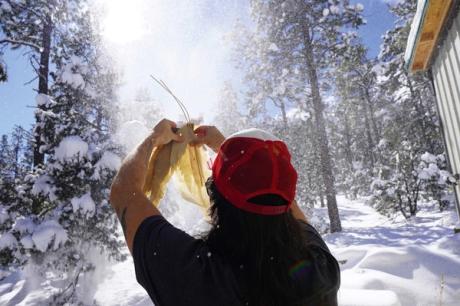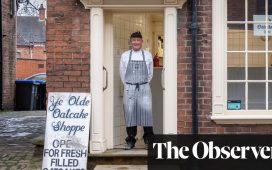Planet Earth will receive a little boost from a major cultural programme launching this autumn. Along with the flurry of around 60 exhibitions in the Getty’s latest PST Art initiative—consuming lots of energy and material resources—will be a range of largely unseen environmental components. The Getty set up the Climate Impact Program (CIP) last year to help participating institutions go green. The initiative seems a natural part of the PST Art programme, especially given this iteration’s “Art & Science Collide” theme, with several exhibitions exploring environmental issues.
“This was something that came to us from our community of curators and participants,” says Joan Weinstein, the director of the Getty Foundation, which funds PST Art. Around two years ago, she says, “we were approached by Debra Scacco and Laura Lupton—Debra is involved in Artists Commit, Laura in Galleries Commit. They said, ‘We would love to present some of our thinking to the larger PST community.’” Both had been involved in efforts to have artists and galleries reduce their ecological footprints.
With an upcoming PST Art meeting scheduled, the Getty decided to organise a session on environmental impact, with Scacco and Lupton talking about their work at the intersection of art and sustainability. The presentation proved so popular that the Getty had them follow up with “a few webinars for our community to start building climate literacy, along with collaborative learning”, Weinstein says. This led to the Getty contracting Lupton and her company LHL Consulting to run what became the CIP for two years, starting last March.
California has long been at the forefront of environmental awareness in the US, so some PST participants already had programmes in place. In 2009, the Museum of Latin American Art (Molaa) in Long Beach installed solar panels, and leaders at the institution hope to update their system in a future expansion. Last year, the Museum of Contemporary Art (Moca) in Los Angeles hired Kelsey Shell for the new position of environmental and sustainability strategist.
The CIP has helped focus PST Art participants on environmental concerns and, through Lupton’s consultancy, they have had direct access to professional help. LHL has provided group webinars and one-on-one consultations. There is also an online portal for participants to learn more about the programme and an “overview of effective actions” in areas such as travel, shipping and energy use. Mainly it is about how to cut down, or find alternative means when possible. Participation is voluntary and free.
Museums and art spaces are taking on the challenge in a number of ways. To cut down on travel, several organisations are making use of “virtual couriering”. Traditionally, certain loaned works had to travel with a courier, often a member of the lending institution, to ensure safe transfer and help make a condition report of the object when unpacked. Now some objects are shipped on their own, and the unpacking is done via live video.
Additional savings of emissions, materials and costs is achieved by consolidating shipments. This may require extra planning, but the Los Angeles Contemporary Exhibitions (Lace) venue was able to add its shipment of archival materials from New York to a truck already travelling to Los Angeles for the Frieze fair in February. “We’re going to be tracking our environmental impact, mainly through carbon emissions and material waste,” says Lace’s deputy director, Fiona Ball. “We’ll be using this like a pilot, now that we have the support and collaboration from the Getty and other institutions, then as a template to continue with each exhibition or major project.”
Transport the artist not the art
Another way to cut down on shipping costs is to transport the artist, rather than the art, as Molaa is doing for its PST Art exhibition, ARTEONICA*: Art, Science, and Technology in Latin America Today. “We invited artists from Argentina, Brazil, Mexico, Peru and Chile to create new works,” says Gabriela Urtiaga, Molaa’s chief curator. The museum will bring them to Southern California for five days to two weeks, when they will also participate in “workshops and conversations with the community and other artists”.
Other PST Art participants are looking at how they can operate their buildings more efficiently by managing heating, cooling and humidity. At least two participating museums—Moca and the Hammer Museum—will adopt the Bizot Green Protocol, a set of recommendations first published in 2015 and updated last year that makes some operational requirements more flexible. “During the planning of our PST exhibition, the Hammer decided to reduce energy consumption,” says Michael Nock, the Los Angeles museum’s director of exhibitions and publications. This autumn, the museum will present Breath(e): Toward Climate and Social Justice. “Bizot was known within the field and already applied by other institutions,” Nock says. Previously, institutions were obligated to hold relative humidity inside galleries at 50%, plus or minus 5% relative humidity, and the temperature at 70°F, plus or minus 2°F, and now they have a wider range of 50% humidity plus or minus 10% relative humidity and 61°F to 77°F. Nock emphasises that when objects are on loan, the lending institution also has to agree to the new guidelines.
Moca will adopt the Bizot protocol for its Olafur Eliasson exhibition in September. “An upcoming HVAC retrofit at the Geffen Contemporary [at Moca] will allow the museum to adjust temperature in real time, shifting to more common-sense energy use practices,” Shell says. “The project will translate to an approximate 25% reduction in that building’s energy use, a great step towards our goal of 50% energy reduction by 2030, in alignment with the Paris Climate Accord.”
Also under consideration is what goes inside the buildings: the materials used to protect and display the art, such as cases, frames and other exhibition preparation. The Huntington Library, Art Museum and Botanical Gardens will also host an environmental exhibition, Storm Cloud: Picturing the Origins of Our Climate Crisis, for PST Art. “The Huntington consistently advocates for the reuse of existing casework and frames for display, as this practice naturally supports sustainability and prevents waste,” says the exhibition’s co-curator, Melinda McCurdy. “The Getty’s Climate Impact Program has certainly inspired innovative thinking and prompted [our] team to reassess the materials that will be used and strive for greener solutions.” She projects cost savings as a result of reusing materials; the Huntington will also employ green materials when possible, McCurdy says, including “reusable ApplePly panels for build and recycled eco-cloth and eco-friendly paper for graphics”.
“Museums are a space of influence and education, and there is great opportunity to mobilise that influence,” Shell says. She points out that two major upcoming solo shows at Moca, Josh Kline: Climate Change and Olafur Eliasson: Open, are climate stories, accompanied by themed events and educational programmes. “We need to reduce our emissions, but we also need to share our emissions reduction process with our peer organisations. We are in this together, and we can’t delay.”









